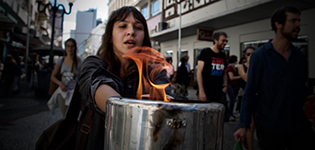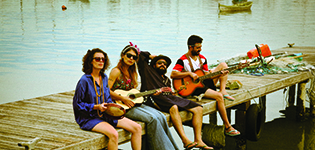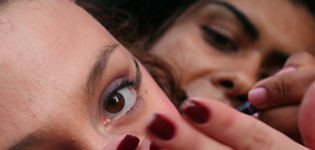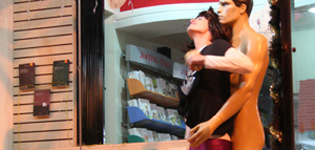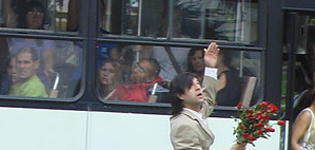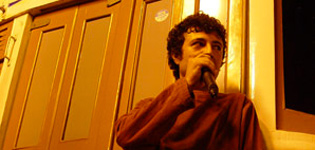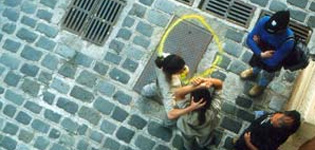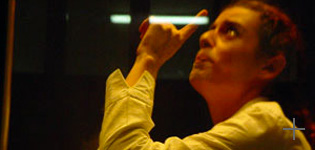Categoria
Pesquisas
Some Initiatives in Pervasive Games in the State of Santa Catarina
Yara Guasque at the 16th International Symposium on Electronic Art in Proceedings of the 16th International Symposium on Electronic Art – 20-29 August 2010 Ruhr / Germany. Presentation at the P 17 – Media Politics of the Local.
Some Initiatives in Pervasive Games in the State of Santa Catarina
Yara Guasque (br) – UDESC – Associate Professor – c2yrga@udesc.br
Focusing on pervasive games, we compare the performative actions of three groups. Influenced by Allan Kaprow’s Happenings and by Augusto Boal’s Invisible Theater, Grupo ERRO follows the line of performances in the tradition of the group Fluxus. Its familiarity with the concept of dérive and of the psychogeography of the Situationist International enabled the group to identify strategies of action, urban space appropriation and displacement, which are confused on the streets with passers-by. The group, coordinated by Pedro Diniz Bennaton, has regional affinities with collective activists of Brazil, like Grupo Laranjas, of Recife, Empreza, of Goiás, and GIA, of Bahia, and also of Latin America, in the actions of H.I.J.O.S. In the urban scenario, which constitutes the group’s stage, improvisations are at the same time protest and entertainment. The interventions build a situation with the public and the street, and confuse reality with fiction, questioning certain social standards, like the one of mental sanity in Carga Viva. In the context of the strategies and esthetics of the game, Buzkashi, an urban intervention of 2004, explores the limits between party and war and abandons the spectacular elements of the theater. Despite the desire to eliminate the frontiers between the spectacle’s artificiality as artistic format and the urban scene, and the fact that the group uses the term expectator instead of spectator, to designate the participant as someone who brings their own context and expectations, there is in the game a clear role division between players and reflexes. Launched in 2006, also blurring the spheres of fiction and reality, which is commonly practiced in the esthetics of the pervasive games, Desvio invited the street’s passersby to represent a murder. Enfim um líder, of 2007, extended the experience into an action that lasted three days. Using posters and the strategy of marketing and political propaganda, the action simulated the introduction of a political candidate on the streets.
Playing of Transforming Reality
Authentic challenges create greater engagement than artificial challenges. The example of Oasis is interesting, because the project stimulates emergency action and the practice of civil society’s governability and autonomy in view of the State’s lack of efficacy. Oasis was created in 2003 by Instituto Elos, a non-governmental organization founded in 2000 by architects and urbanists, which is also responsible for Guerreiros sem Armas. The strategy is cooperative social entrepreneurship both in Oasis and in Oasis SC, of 2008, on which we focus in this paper. Without an esthetic concern, the project uses the social platform Ning on the internet to call for participation, to schedule and distribute collective tasks like the construction of the interface in the platform and the formation of the teams for the collective reconstruction of flooded communities in Santa Catarina. The project has a national scope, creating many work fronts. In an interview, Einstein, a Computer Sciences student of ITA and someone that participated since the beginning of 2009 in Oasis SC, highlights in his experience the voluntary participation of all, and the donations, even the technological ones, received without using the propaganda of the logotypes of the involved companies.
Between the Artificiality of Artistic Language and the Participation of the Civil Society
Ciberestuário Manguezais is a development of Mar Memorial Dinâmico – an installation that uses tangible interfaces (2009) and Web Art (2008). The call for participation in Ciberestuário Manguezais focused firstly on the mangrove swamp of Itacorubi due to easy access and because it is where the university is located, promoting the students’ reflection on the occupation. As the physical-chemical parameters that we would collect with the embedded system are monitored by companies that subsidize the production of mollusks in Santa Catarina’s coast, the main strategy of Ciberestuário Manguezais is now the access to information and the appropriation of diverse means of communication and publicity. The utilization of the social platforms that already existed implied the redirection of the esthetics to the co-authored narratives and the community’s appropriations of knowledge about the environment produced by the scientific community, making them become a public property. The investigation’s character of pervasive game facilitated the different levels of participation, and also enabled the project to transpose the neutrality of certain esthetic propositions, acting in the sphere of the concrete.
Interacting with the Community
Comparing with the already established genres of pervasive games mentioned by the authors STENROS and MONTOLA (2009,31-45) and like in Treasure Hunt games, Ciberestuário Manguezais promotes the search for data in the physical area to compose the mangrove swamp page in the social platform. Grupo ERRO’s actions in the urban space are similar to Public Performances games, like Carga Viva 2002, Buzkashi 2004, Desvio 2006 and Enfim um Líder 2007. Oasis SC and Ciberestuário Manguezais use diverse technologies in the colonization of new platforms. Similar to Real Games, considered by MONTOLA, STENROS and WAERN a pervasive Paidia, and not a game, they promote playful activities and performative actions in the physical world, raising the participants’ awareness about the region where they live.
References
Araujo,Y. (2010) ‘Plataforma multiuusário “nome e a ser escolhido pela população local”.
Sedimentando um ciberestuário?’ II Symposium Proceedings ABCiber. Retrieved from: http://www. cencib.org/simposioabciber/anais/mesa/pd/Yara_Rondon_Guasque_Araujo.pdf [Accessed 10 Feb. 2010]
Bennaton, P. (2009) Deslocamento e Invasão. Master Dissertation UDESC.
Montola, M.; Stenros, J.; Waern, A., (2009) Theory and Design. Pervasive Games. Experiences on the Boundary Between Life and Play. Oxford: Elsevier.
16th International Symposium on Electronic Art
20-29 August 2010 – Ruhr / Germany
Proceedings of the 16th International Symposium on Electronic Art
Presentation at the P 17 – Media Politics of the Local.
ISEA2010 RUHR is a project of RUHR.2010 European Capital of Culture.



